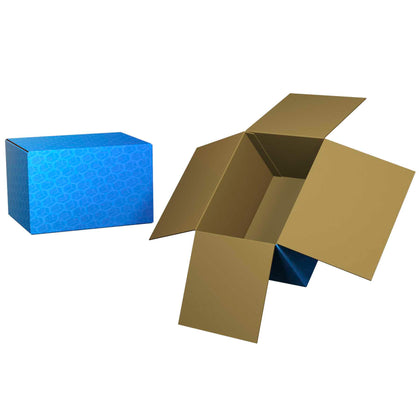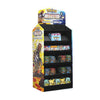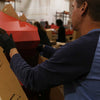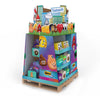

Sustainable Packaging Is Possible
In today's society, many people are concerned with being sustainable, and it's understandable. Many customers want to buy products that are in-line with their morals, and packaging is a great place to start. Because packaging is one of the greatest existential threats facing society.
Most custom product packaging is designed to be single-use, and then thrown away or recycled. That's why corrugated packaging can be the best solution for the market, it can be recycled up to 7 times!
While other materials can be recycled, corrugated has the highest recycle rate. It's also very sturdy and protects your products during shipping.
If your brand is working to be more sustainable, or you just want to see what other eco-friendly options are on the market, you came to the right place. Here are five tips to make your boxes more sustainable.
Table Of Contents
Tip #1 Rearrange Your Products For More Efficiency
The less air you ship, the less you are wasting on freight costs. Sometimes brands will buy stock boxes, or simply add filler to the box to keep their products secure and safe for shipping.
With fewer components in your package, you're conserving resources, saving space in transportation, and reducing the burden of disposal on the client. When planning your unwrapping experience, strive to utilize as little packaging as possible to ensure that your product arrives securely.
Trying to rearrange your products into a more efficient configuration can help you save money.
Tip #2 Avoid Mixing Materials
Because the layers can't be separated in sorting, when paper and plastic, or even two types of plastic, are fused together, they're no longer recyclable. Stick to packaging that is completely comprised of paper or a single type of plastic.
The presence of small amounts of mixed materials stacked onto paper (such as paper strengthened with fiberglass strands or boxes sealed with plastic tape) does not rule it out for recycling. It will impact the amount it can be recycled, so check with a recycling plant in your city.
Tip #3 Switch To High-Speed Digital Printing
Digitally Printed Packaging is a great way to become more sustainable without limiting yourself. This printing method typically uses 18% less resources like water and electricity, and creates as much as 24% less waste.
There are no printing plates, which is a huge source of waste in packaging. But that also means you can print as many graphics as you like. One for each region, retailer, and SKU.
When you switch to Digital Printing, it can literally change your packaging from plain to premium.
Tip #4 Order Less Virgin Material
It's best if you can keep resources in use for as long as possible. The more recycled material you use, whether it's plastic or paper, the less fresh resources you consume from the environment.
While virgin material is a great way to increase the overall strength, it does increase your impact on the environment. If your manufacturer doesn't offer alternative options, find another that does.
Tip #5 Add Something Instead Of Subtracting
Another way to make your packaging more sustainable is to add something to the design instead of simply removing things.
We worked with a customer to create a custom design to include a Seed Paper slip for customers to plant. It not only made their brand more sustainable by focusing on their packaging, it enhanced their marketing. It also helped them establish a relationship with a new retailer.
Tip #6 Ship In Smaller Packaging When Possible
When it comes to package sizes, there are usually two approaches. To optimize for varied product assortments, one technique is to employ a wide variety of sizes. Another method is to use only a few packing sizes and use a one-size-fits-all approach.
Shipping Between Warehouses
Shipping products between warehouses, vendors, and distribution centers can quickly eat into your margin. Shrinking your packaging size reduces expenses, material prices, resources, and emissions on all of that transit.
Shipping To Customers
Optimizing packaging starts with understanding your customer behavior. If another DC would simply your shipping and packaging requirements, invest in one. Or if customers are preferring combo-packs, incentive those purchases and optimize the packaging.
Tip #7 Check Your Tertiary Packaging
If you're shipping products and SKUs in bulk, you're using Tertiary packaging. And sometimes you're not using an optimized design.
Work with your manufacturing and shipping teams to do an analysis on your current usage. Find efficiencies and reduce the waste. There three levels of packaging, but Tertiary is often overlooked.
Tip #8 Try Recycled And Renewable Materials
Sourcing recycled paper for your cartons is very important. But not only does using recycled paper mean you're helping the environment, it can also be cheaper! Paper made from 100% recycled post-consumer waste has no debits for landfill space and water consumption during manufacturing; since the materials used (tree pulp) are a renewable resource and would eventually decompose on their own anyway.
Bioplastics, for example, are a new type of sustainable material that can help us lessen our dependence on fossil fuels.
Biodegradability and compostability are two features that these alternative materials can offer. These materials are frequently more expensive due to restricted supply, but as more businesses embrace them, costs will decrease as production scales up to meet demand.
Tip #9 Analyze Your Supply Chain For Over-Packaging
Your supply chain has thousands of touchpoints for both your product and its container. Before they come to you, items are bagged, baled, or bundled at each of these touchpoints, typically with additional packaging. These layers are added to keep your goods clean, safe, and organized, but there are times when less packaging might have the same effect.
Talk to your production partners to have a better understanding of these touchpoints, and you can find some chances to save money on materials. Make sure to do a packaging supply chain audit once in awhile.
Tip #10 Find A Sustainable Manufacturer
Packaging manufacturers may practice sustainability in a variety of ways, including reducing power or water use, optimizing machineries, and even time management. It's possible for manufacturers to be sustainable not only with the materials they use, but in their own practices.
When you work with a company that knows how to become sustainable, your customers will notice when they see your product. Not only is it great practice to align yourself with sustainability, it can even have some financial benefits down the road.
Create Sustainable Packaging With Bennett!
If you want to be more sustainable and reduce your environmental impact, there are a number of things you can do. First, consider the materials that go into your packaging such as recycled paper or bioplastics. It's also important to work with manufacturers who practice sustainability in their own practices so they know what is expected of them. If all this seems overwhelming and costly, we're here for you!
We have an extensive team ready to help turn your idea into reality- let us know how we can partner with you on creating a stellar new product package that leaves less of an ecological footprint than before.
Frequently Asked Questions
Is Sustainable Packaging Weaker?
No. Sustainable Packaging can be just as structurally sound as other traditional options. And you should only use a box that is sturdy enough for your supply chain.
Is Sustainable Packaging More Expensive?
Not necessarily. Sustainable Packaging can mean many things, including reducing inefficiencies, changing materials and coating, and more. It can actually reduce the price sometimes.
Does Sustainable Packaging Increase Sales?
While switching your packaging to a more sustainable option will help expand your marketing capabilities, it doesn't mean it will directly increase sales. But it's a great thing to try to increase sales!




